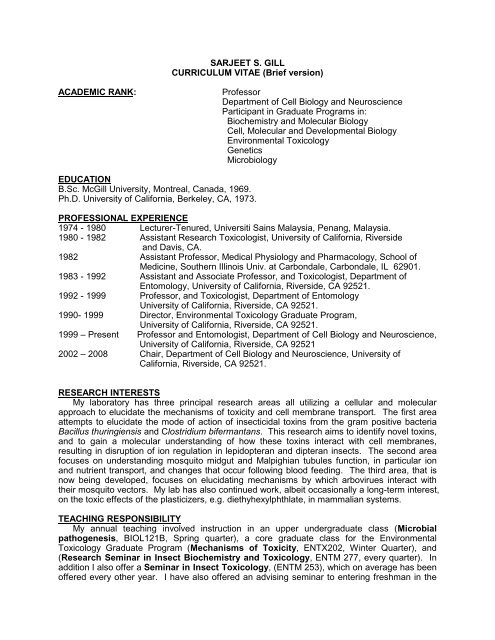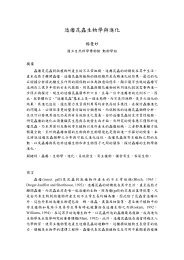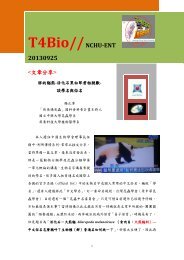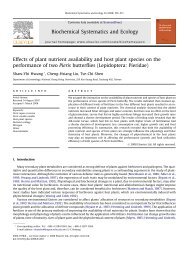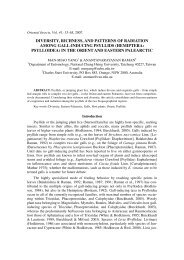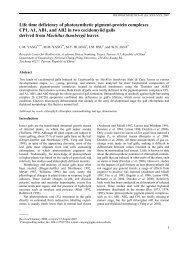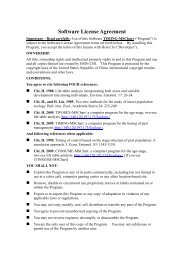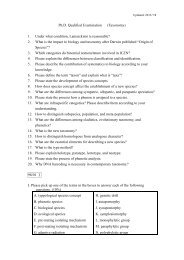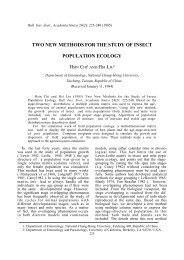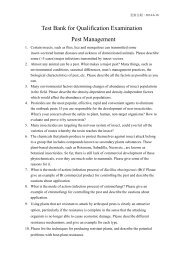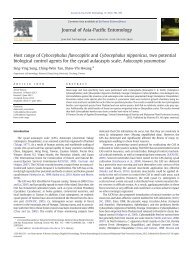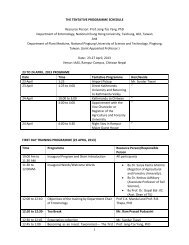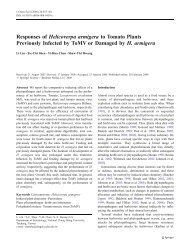SARJEET S. GILL CURRICULUM VITAE (Brief version) ACADEMIC ...
SARJEET S. GILL CURRICULUM VITAE (Brief version) ACADEMIC ...
SARJEET S. GILL CURRICULUM VITAE (Brief version) ACADEMIC ...
Create successful ePaper yourself
Turn your PDF publications into a flip-book with our unique Google optimized e-Paper software.
<strong>SARJEET</strong> S. <strong>GILL</strong><strong>CURRICULUM</strong> <strong>VITAE</strong> (<strong>Brief</strong> <strong>version</strong>)<strong>ACADEMIC</strong> RANK:ProfessorDepartment of Cell Biology and NeuroscienceParticipant in Graduate Programs in:Biochemistry and Molecular BiologyCell, Molecular and Developmental BiologyEnvironmental ToxicologyGeneticsMicrobiologyEDUCATIONB.Sc. McGill University, Montreal, Canada, 1969.Ph.D. University of California, Berkeley, CA, 1973.PROFESSIONAL EXPERIENCE1974 - 1980 Lecturer-Tenured, Universiti Sains Malaysia, Penang, Malaysia.1980 - 1982 Assistant Research Toxicologist, University of California, Riversideand Davis, CA.1982 Assistant Professor, Medical Physiology and Pharmacology, School ofMedicine, Southern Illinois Univ. at Carbondale, Carbondale, IL 62901.1983 - 1992 Assistant and Associate Professor, and Toxicologist, Department ofEntomology, University of California, Riverside, CA 92521.1992 - 1999 Professor, and Toxicologist, Department of EntomologyUniversity of California, Riverside, CA 92521.1990- 1999 Director, Environmental Toxicology Graduate Program,University of California, Riverside, CA 92521.1999 – Present Professor and Entomologist, Department of Cell Biology and Neuroscience,University of California, Riverside, CA 925212002 – 2008 Chair, Department of Cell Biology and Neuroscience, University ofCalifornia, Riverside, CA 92521.RESEARCH INTERESTSMy laboratory has three principal research areas all utilizing a cellular and molecularapproach to elucidate the mechanisms of toxicity and cell membrane transport. The first areaattempts to elucidate the mode of action of insecticidal toxins from the gram positive bacteriaBacillus thuringiensis and Clostridium bifermantans. This research aims to identify novel toxins,and to gain a molecular understanding of how these toxins interact with cell membranes,resulting in disruption of ion regulation in lepidopteran and dipteran insects. The second areafocuses on understanding mosquito midgut and Malpighian tubules function, in particular ionand nutrient transport, and changes that occur following blood feeding. The third area, that isnow being developed, focuses on elucidating mechanisms by which arbovirues interact withtheir mosquito vectors. My lab has also continued work, albeit occasionally a long-term interest,on the toxic effects of the plasticizers, e.g. diethyhexylphthlate, in mammalian systems.TEACHING RESPONSIBILITYMy annual teaching involved instruction in an upper undergraduate class (Microbialpathogenesis, BIOL121B, Spring quarter), a core graduate class for the EnvironmentalToxicology Graduate Program (Mechanisms of Toxicity, ENTX202, Winter Quarter), and(Research Seminar in Insect Biochemistry and Toxicology, ENTM 277, every quarter). Inaddition I also offer a Seminar in Insect Toxicology, (ENTM 253), which on average has beenoffered every other year. I have also offered an advising seminar to entering freshman in the
Curriculum vitae: Sarjeet S. GillUniversity of Califronia Riversidelife sciences, and am currently planning a course based on active learning for enteringfreshman in the life sciences.PROFESSIONAL SOCIETIESMember of the American Chemical Society; American Association for the Advancement ofScience; Society of Invertebrate Pathology, and Entomological Society of America.PROFESSIONAL SERVICEReview PanelsTropical Medicine and Parasitology Study Section, National Institutes of Health; 1987-1989,1993, 1999, 2002,Vector Biology Study Section, National Institutes of Health; 2005, 2009USDA, Entomology study section 1987-88, 1997, 2009, 2010.Reviewer of grants from USDA, NSF, Welcome Trust, U.K., BBRC, U.K; New Zealand CSIR;International Foundation for Science, Sweden; Texas A&M University; University ofNevada, Reno; UC Toxic Substances Teaching and Research Program.UC Toxic Substances Teaching and Research Program – Panel Member, 2001-2009Scientific Review Panel, California Air Resources Board, State of California, 2010-Present.Manuscript reviews:Reviewed manuscripts for Science, Proceedings National Academy of Sciences, QuarterlyReview of Biology, Biological Bulletin, J. Experimental Biology, J. Neuroscience, J.Biological Chemistry, European J. Biochemistry, J. Agricultural Food Chem., BiochemistryBiophysics Acta, Comparative Biochemistry and Physiology, FEBS Lett., BMC Genomics,PLOSone, Insect Biochemistry and Molecular Biology, Insect Molecular Biology, ArchivesInsect Biochemistry and Physiology, Pesticide Biochemistry and Physiology, InsectPhysiology, Gene, Nucleic Acids Research, Molecular and Cellular Endocrinology,Molecular Pharmacology, Biochemical Pharmacology, Molecular Microbiology, AppliedEnvironmental Microbiology, Canadian J. Microbiology, Research in Microbiology, J.Invertebrate Pathology, Journal of Medical Entomology, Entomologia Experimentalis etApplicata, Annual Review of Entomology, Plant Physiology, and book chapters.Other Reviews:Review of the California OEHHA report on ATRAZINE (1998-99)Review of the California OEHHA report on Silvex (2001)Review of UCLA’s Ph.D. program on Molecular Toxicology (1998-99)National Academies report on “Genetically Modified Pest-Protected Plants: Science andRegulation” (1999-00)Editorial Boards:Member of Editorial Board, Ann. Rev. Entomology 1993-1998.Member of Editorial Board, Insect Biochemistry and Molecular Biology. 1997-PresentMember of Editorial Board, Research in Chemical Toxicology, 2000-2005Chief Co-Editor, Insect Biochemistry and Molecular Biology, January 2007-Present.Book Editor:Co-editor with L. I. Gilbert, K. Iatrou on 6 volume revision of the 1 st edition of ComprehensiveInsect Physiology Biochemistry, and Pharmacology. Completed 2005.Co-editor with L. I. Gilbert on Insect Control, Completed 2010.Co-editor with L. I. Gilbert on Insect Pharmacology, Completed 2010.2
Curriculum vitae: Sarjeet S. GillUniversity of Califronia RiversidePUBLICATIONS (Total 152), since 20051. Bravo, A., S. S. Gill, A. Bravo, and M. Soberón. 2005. Bacillus thuringiensis, withResistance mechanisms, In Comprehensive Molecular Insect Science (Ed. L.I. Gilbert, I.Kostas and S.S.Gill), Elsevier, Vol 6, 175-205.2. Gilbert, L. I., I. Kostas and S. S. Gill. 2005. Comprehensive Molecular Insect Science.Vols 1-7. Elsevier Pergammon, Amsterdam.3. Xie, R., M. Zhuang, L. S. Ross, I. Gomez, D. I. Oltean, A. Bravo, M. Soberón and S. S.Gill. 2005. Single amino acid mutations in the cadherin receptor from Heliothisvirescens affect its toxin binding ability to Cry1A toxins. J. Biol. Chem. 280: 8416-8425.4. Fernandez L.E., C. Perez, L. Segovia, M. H. Rodriguez, S. S. Gill, A. Bravo, and M.Soberón. 2005. Cry11Aa toxin from Bacillus thuringiensis binds its receptor in Aedesaegypti mosquito larvae through loop alpha-8 of domain II.. FEBS Lett. 579:3508-14.5. Sanders, H. R., B. D. Foy, A. M. Evans, L. S. Ross, B. J. Beaty, K. E. Olson and S. S.Gill. 2005. Sindbis virus induces transport processes and alters expression of innateimmunity pathway genes in the midgut of the disease vector, Aedes aegypti. InsectBiochem. Mol. Biol. 35:1293-307.6. Liu Y, Y. Zhang, K. Schmelzer, T.S. Lee, X. Fang, Y. Zhu, A. A. Spector, S. S. Gill, C.Morisseau, B. D. Hammock, and J. Y. Shyy. 2005. The antiinflammatory effect oflaminar flow: The role of PPAR{gamma}, epoxyeicosatrienoic acids, and soluble epoxidehydrolase. Proc. Natl. Acad. Sci. USA 102: 16747–16752.7. Perez C, L.E. Fernandez, J. Sun, J.L. Folch, S. S. Gill, M. Soberon, and A. Bravo A.2005. Bacillus thuringiensis subsp. israelensis Cyt1Aa synergizes Cry11Aa toxin byfunctioning as a membrane-bound receptor. Proc Natl Acad Sci U S A. 102:18303-18308.8. Fernandez L.E., K. G. Aimaniova, S. S. Gill, A. Bravo, and M. Soberón. 2006. A GPIanchoredalkaline phosphatase is a functional midgut receptor of Cry11Aa toxin inAedes aegypti larvae.. Biochem. J. 394:77-84.9. Aimanova, K.G., M. Zhuang and S. S. Gill. 2006. Expression of Cry1Ac cadherinreceptors in insect midgut and cell lines. J Invertebr Pathol. 92:178-187.10. Pullikuth, A. K., K. Aimanova, W. Kang’ethe, H. R. Sanders and S. S. Gill. 2006.Molecular characterization of sodium/proton exchanger 3 (NHE3) from the yellow fevervector, Aedes aegypti. J. Exp. Biol. 209:3529-3544.11. Patrick, M. L., K. Aimanova, H. R. Sanders and S. S. Gill. 2006. P- type Na+/K+ATPase and V-type H+ ATPase expression patterns in the osmoregulatory organs oflarval and adult mosquito Aedes aegypti J. Exp. Biol. 209):4638-4651.12. Bravo, A., S. S. Gill, A. and M. Soberón. 2007. Mode of action of Bacillus thuringiensisCry and Cyt toxins and their potential for insect control. Toxicon 49:423-435.3
Curriculum vitae: Sarjeet S. GillUniversity of Califronia Riverside13. Soberón, M., L. E. Fernandez, C. Pérez, C., S. S. Gill, and A. Bravo, 2007 Mode ofaction of mosquitocidal Bacillus thuringiensis toxins. Toxicon 49:597-600.14. Kang’ethe, W. K., G. Aimanova, A. K. Pullikuth, and S. S. Gill. 2007. NHE8 mediatesamiloride sensitive Na + /H + exchange across mosquito Malpighian tubules and catalyzesNa + And K + transport in reconstituted proteoliposomes. Am. J. Physiol. Physiol.292:F1501-12.15. Jiménez-Juárez, N., Muñoz-Garay, C., Gómez, I., Saab-Rincon, G., Damian-Almazo, J.Y., Gill, S. S., Soberón, M., and Bravo A. 2007. Bacillus thuringiensis Cry1Ab mutantsaffecting oligomer formation are non-toxic to Manduca sexta larvae. J Biol Chem.282:21222-21229.16. Pérez C, Muñoz-Garay C, Portugal LC, Sánchez J, Gill SS, Soberón M, and Bravo A.2007. Bacillus thuringiensis subsp. israelensis Cyt1Aa enhances activity of Cry11Aatoxin by facilitating the formation of a pre-pore oligomeric structure. CellularMicrobiology. 9: 2931-2937.17. Kim YJ, Nachman RJ, Aimanova K, Gill S, Adams ME. 2008. The pheromonebiosynthesis activating neuropeptide (PBAN) receptor of Heliothis virescens:identification, functional expression, and structure-activity relationships of ligand analogs.Peptides. 29:268-75.18. Jiménez-Juárez, N., Muñoz-Garay, C., Gómez, I., Gill, S. S., Soberón, M., and Bravo, A.2008. The pre-pore from Bacillus thuringiensis Cry1Ab toxin is necessary to induceinsect death in Manduca sexta. Peptides. 2008 29:318-2319. Fernández, L. E., Gómez, I., Pacheco, S., Arenas, I., Gill, S. S., Bravo, A., and Soberón,M. 2008. Employing phage display to study the mode of action of Bacillus thuringiensisCry toxins. Peptides. 2008 29:324-9.20. Pacheco S, Gómez I, Gill SS, Bravo A, and Soberón M. 2008. Enhancement ofinsecticidal activity of Bacillus thuringiensis Cry1A toxins by fragments of a toxin-bindingcadherin correlates with oligomer formation. Peptides. 29:324-29.21. Soberón M, Gill SS, and Bravo A. 2009. Signaling versus punching hole: How doBacillus thuringiensis toxins kill insect midgut cells? Cell Mol Life Sci. 266:1337–1349.22. Likitvivatanavong, S., Aimanova, K. and Gill, S. S. 2009. Loop residues of the receptorbinding domain of Bacillus thuringiensis Cry11Ba toxin are important for mosquitocidalactivity. FEBS Lett. 583: 2021-2030.23. Fernandez, L., Martinez-Anaya C., Lira E., Chen, JW., Evans, A., Hernández-Martínez,S., Lanz-Mendoza H., Bravo, A., Gill, S. S., Soberón, M. 2009. Cloning and epitopemapping of Cry11Aa-binding sites in the Cry11Aa-receptor alkaline phosphatase fromAedes aegypti. Biochemistry. 48, 8899–8907.24. Evans, A. M., Aimanova, K. G. and S. S. Gill. 2009. Characterization of a Blood MealResponsive Proton Dependent Amino Acid Transporter in the Disease Vector, Aedesaegypti. J. Exp. Biol. 212: 3263-3271.4
Curriculum vitae: Sarjeet S. GillUniversity of Califronia Riverside25. Chen, J.W., Aimanova, K., Martinez, C., Bravo, A., Soberon, M., Gill, S. S. 2009. Aedesaegypti cadherin serves as a putative receptor of the Cry11Aa toxin from Bacillusthuringiensis subsp. israelensis. Biochemical J. 424:191-200.26. Chen, J. W., Aimanova, K., Pan, S. Q, Gill, S. S. 2009. Identifications andcharacterization of Aedes aegypti aminopeptidase N as putative receptors of Bacillusthuringiensis Cry11A toxin. Insect Biochem. Mol. Biol. 39:688-696..27. Fernandez-Luna MT, Lanz-Mendoza H, Gill SS, Bravo A, Soberon M, Miranda-Rios J.2010. An alpha-amylase is a novel receptor for Bacillus thuringiensis ssp. israelensisCry4Ba and Cry11Aa toxins in the malaria vector mosquito Anopheles albimanus(Diptera: Culicidae). Environ Microbiol. 12:746-5728. Pacheco, S., Gomez, I., Arenas, I., Saab, G., Rodríguez-Almazán, C., Gill, S. S., Bravo,A. and Soberon, M. 2009. Domain II loop 3 of Bacillus thuringiensis Cry1Ab toxin isinvolved in a “ping pong” binding mechanism with Manduca sexta aminopetidase-N andcadherin receptors. J. Biol. Chem., 284:32750-32757.29. Cancino-Rodezno., A., Alexander, C., Villaseñor, R., Pacheco, S., Porta, H., Pauchet, Y.,Soberón, M., Gill, S.S. and Bravo, A. 2010. The mitogen-activated protein kinase p38 isinvolved in insect defense against Cry toxins from Bacillus thuringiensis. Insect Biochem.Mol. Biol. 40:58-63.30. Likitvivatanavong, S., Chen, J., Bravo, A., Soberon, M., Gill, S. S. 2011. Cadherin,alkaline phosphatase, and aminopeptidase N as receptors of Cry11Ba roxin fromBacillus thuringiensis subsp. jegathesan in Aedes aegypti. Appl. Environ. Microbiol 77:24–31.31. Rodriguez-Almazan, C., Ruiz de Escudero, I., Canton, P.C., Munoz-Garay, C, Perez, C.,Gill, S.S., Soberon, M. and Bravo, A. 2011. The Amino- and Carboxyl-TerminalFragments of the Bacillus thuringensis Cyt1Aa Toxin Have Differential Roles in ToxinOligomerization and Pore Formation. Biochem. 50, 388–396.32. Likitvivatanavong, S., Chen, J., Bravo, A., Soberon, M., and Gill, S. S. 2011. MultipleReceptors as Targets of Cry Toxins in Mosquitoes, J. Agric. Fd. Chem, 59:2829-38.33. Bravo, A., Likitvivatanavong, S., Gill, S. S., and Soberón, M. 2011. Bacillusthuringiensis: A story of a successful bioinsecticide. Insect Biochem Mol Biol. 41:423-31.34. Campbell, C.L, Lehmann, C. J, Gill, S. S, Dunn, W. A, James, A. A, and Foy, B. D.2011. A role for endosomal proteins in alphavirus dissemination in mosquitoes. Ins. MolBiol. 20:429-436.Current Grant Support:UCR/AES/RACResearch supported by a grant from the NIH/NIAID and5


